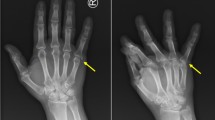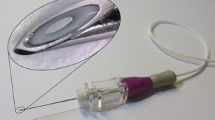Abstract
Objective
Hyperechoic microfoci are sometimes visualized in normal joints. We hypothesized that these microfoci may correspond to gas microbubbles produced by a vacuum phenomenon. The purpose of our study was to demonstrate the possibility of generating intraarticular hyperechoic microbubbles by creating a vacuum phenomenon through traction on a metacarpophalangeal joint.
Materials and methods
We applied manual traction to the second metacarpophalangeal (MCP) joint of 22 volunteer subjects to separate articular surfaces with the aim of producing a vacuum. For one subject, the production of a vacuum was verified on a radiograph performed during the traction maneuver. For all subjects, ultrasonographic examination of the MCP joints was performed before, during, and after traction maneuvers. Two radiologists evaluated the presence of intraarticular hyperechoic microfoci and measured the widening of the joint space during traction.
Results
In the first subject, the widening of the joint space and the production of an intraarticular gas-like cavity by traction was confirmed on the radiograph. In 10 out of the 22 volunteers, the widening of the joint space was immediately followed by the appearance of a large intraarticular hyperechoic band, which disappeared when the traction was stopped, followed by the appearance of hyperechoic microfoci that persisted several minutes. The widening of the joint during the traction maneuver was greater in the group where hyperechoic foci were produced than in the group with no hyperechoic foci (mean 2.5 vs. 1.2 mm and 2.2 vs. 0.8 mm, respectively, for observers 1 and 2; P < 0.05, Mann-Whitney U test).
Conclusion
Intraarticular hyperechoic microfoci may be produced and persist in normal joints after a traction maneuver. They are presumed to correspond to microbubbles created by a transient vacuum phenomenon.






Similar content being viewed by others
References
Van Holsbeeck MT, Introcaso JH. Sonography of large synovial joints. In: Van Holsbeeck MT, editor. Musculoskeletal ultrasound. St. Louis: Mosby; 2001. p. 235–75.
Zamorani MP, Valle M. Bone and joint. In: Bianchi S, Martinoli C, editors. Ultrasound of the musculoskeletal system. Heidelberg: Springer; 2007. p. 137–85.
Fuiks DM, Grayson CE. Vacuum pneumoarthrography and the spontaneous occurrence of gas in the joint spaces. J Bone Joint Surg Am. 1950;32(A:4):933–8.
Resnick D, Niwayama G, Guerra J, Vint V, Usselman J. Spinal vacuum phenomena: anatomical study and review. Radiology. 1981;139(2):341–8.
Resnick D. Degenerative disease of the spine. In: Resnick D, editor. Diagnosis of bone and joint disorders. 4th ed. WB Saunders: Philadelphia; 2002. p. 1382–475.
Stallenberg B, Madani A, Burny F, Gevenois PA. The vacuum phenomenon: a CT sign of nonunited fracture. AJR Am J Roentgenol. 2001;176(5):1161–4.
Unsworth A, Dowson D, Wright V. Cracking joints. A bioengineering study of cavitation in the metacarpophalangeal joint. Ann Rheum Dis. 1971;30(4):348–58.
Chan YL, Cheng JC, Tang AP. Voluntary habitual dislocation of the hip: sonographic diagnosis. Pediatr Radiol. 1993;23(2):147–8.
Hammar MV, Wintzell GB, Aström KG, Larsson S, Elvin A. Role of US in the preoperative evaluation of patients with anterior shoulder instability. Radiology. 2001;219(1):29–34.
Morvan G, Mathieu P, Vuillemin-Bodaghi V, Wybier M, Busson J. Sémiologie échographique des épanchements gazeux intra-articulaires provoqués. Gel-Contact. 2005;1439-42.
Grechenig W, Clement H, Peicha G, Passler JM, Mayr J, Weiglein A. Ultrasonographic imaging of pneumarthrosis of the knee joint–case report and experimental cadaver study. Ultraschall Med. 2002;23(1):47–51.
Koski JM, Hermunen HS, Kilponen VM, Saarakkala SJ, Hakulinen UK, Heikkinen JO. Verification of palpation-guided intra-articular injections using glucocorticoid-air-saline mixture and ultrasound imaging (gas-graphy). Clin Exp Rheumatol. 2006;24(3):247–52.
Wakefield R, O’Connor P. All that glimmers is not gold. Semin Arthritis Rheum. 2007;37(2):133–4.
Middleton WD, McAlister WH. Hip joint fluid in the presence of the vacuum phenomenon. Pediatr Radiol. 1986;16(2):171–2.
Yousefzadeh DK. The value of traction during roentgenography of the wrist and metacarpophalangeal joints. Skeletal Radiol. 1979;4(1):29–33.
Wright DM, Sochart DH. Spontaneous vacuum phenomenon in the lateral compartment of the knee associated with a lateral tibial plateau fracture. Knee. 2006;13(1):42–4.
Acknowledgments
The authors thank Geneviève Depresseux for statistical analysis.
Conflict of interest
No disclosure to make for any of the authors.
Author information
Authors and Affiliations
Corresponding author
Rights and permissions
About this article
Cite this article
Malghem, J., Omoumi, P., Lecouvet, F.E. et al. Presumed intraarticular gas microbubbles resulting from a vacuum phenomenon: visualization with ultrasonography as hyperechoic microfoci. Skeletal Radiol 40, 1287–1293 (2011). https://doi.org/10.1007/s00256-011-1107-5
Received:
Revised:
Accepted:
Published:
Issue Date:
DOI: https://doi.org/10.1007/s00256-011-1107-5




